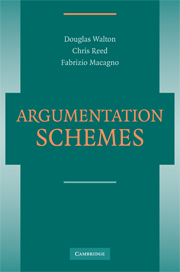Book contents
- Frontmatter
- Contents
- Acknowledgments
- Introduction
- 1 Basic Tools in the State of the Art
- 2 Schemes for Argument from Analogy, Classification, and Precedent
- 3 Knowledge-Related, Practical, and Other Schemes
- 4 Arguments from Generally Accepted Opinions, Commitment, and Character
- 5 Causal Argumentation Schemes
- 6 Schemes and Enthymemes
- 7 Attack, Rebuttal, and Refutation
- 8 The History of Schemes
- 9 A User's Compendium of Schemes
- 10 Refining the Classification of Schemes
- 11 Formalizing Schemes
- 12 Schemes in Computer Systems
- Bibliography
- Index
Introduction
Published online by Cambridge University Press: 05 June 2012
- Frontmatter
- Contents
- Acknowledgments
- Introduction
- 1 Basic Tools in the State of the Art
- 2 Schemes for Argument from Analogy, Classification, and Precedent
- 3 Knowledge-Related, Practical, and Other Schemes
- 4 Arguments from Generally Accepted Opinions, Commitment, and Character
- 5 Causal Argumentation Schemes
- 6 Schemes and Enthymemes
- 7 Attack, Rebuttal, and Refutation
- 8 The History of Schemes
- 9 A User's Compendium of Schemes
- 10 Refining the Classification of Schemes
- 11 Formalizing Schemes
- 12 Schemes in Computer Systems
- Bibliography
- Index
Summary
The theory of argumentation is a rich interdisciplinary area of research spanning philosophy, communication studies, linguistics, computer science, and psychology. In the past few years, formal models of argumentation have been steadily gaining importance in artificial intelligence, where they have found a wide range of applications in specifying semantics for logic programs, generating natural language text, supporting legal reasoning, and facilitating multi-agent dialogue and negotiation on the Internet. The most useful and widely used tool so far developed in argumentation theory is the set of argumentation schemes. Argumentation schemes are forms of argument (structures of inference) that represent structures of common types of arguments used in everyday discourse, as well as in special contexts like those of legal argumentation and scientific argumentation. They include the deductive and inductive forms of argument that we are already so familiar with in logic. However, they also represent forms of argument that are neither deductive nor inductive, but that fall into a third category, sometimes called defeasible, presumptive, or abductive. Such an argument may not be very strong by itself, but may be strong enough to provide evidence to warrant rational acceptance of its conclusion, given that its premises are acceptable (Toulmin, 1958). Such an argument can rightly carry weight, or be a plausible basis for acceptance, on a balance of considerations in an investigation or discussion that is moving forward, as new evidence is being collected.
- Type
- Chapter
- Information
- Argumentation Schemes , pp. 1 - 6Publisher: Cambridge University PressPrint publication year: 2008
- 2
- Cited by



